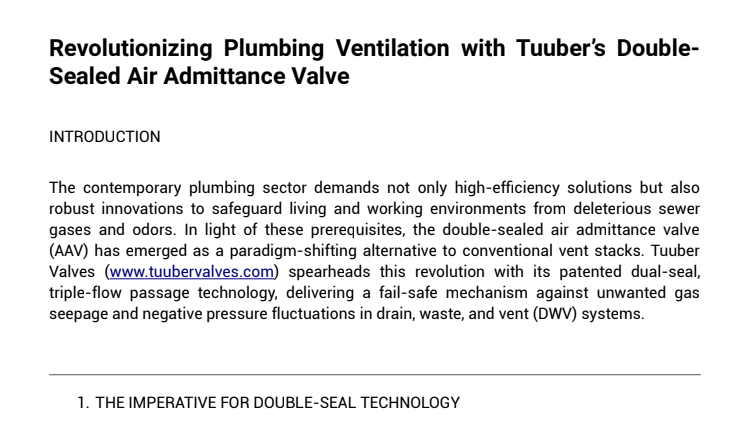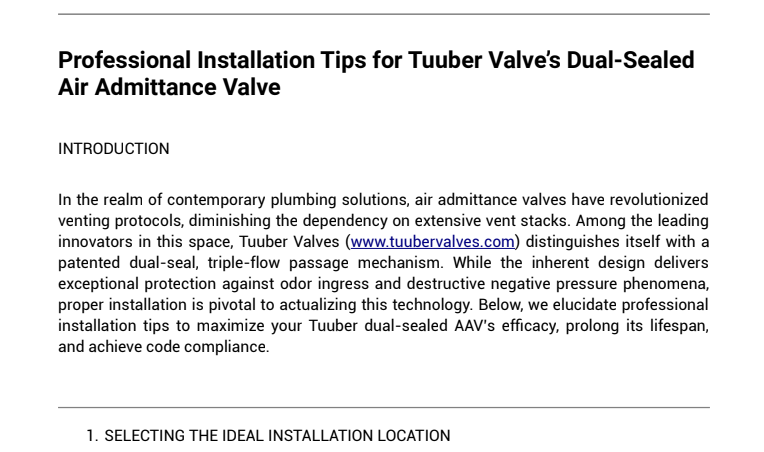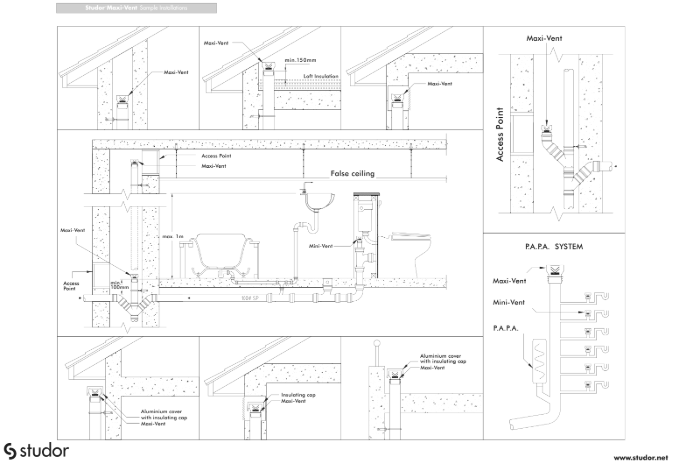Articles
Air Admittance Valves
Revolutionizing Plumbing Ventilation with Tuuber’s Double- Sealed Air Admittance Valve
 Download Article
Download ArticleRevolutionizing Plumbing Ventilation with Tuuber’s Double-
Sealed Air Admittance Valve
INTRODUCTION
The contemporary plumbing sector demands not only high-efficiency solutions but also
robust innovations to safeguard living and working environments from deleterious sewer
gases and odors. In light of these prerequisites, the double-sealed air admittance valve
(AAV) has emerged as a paradigm-shifting alternative to conventional vent stacks. Tuuber
Valves (www.tuubervalves.com) spearheads this revolution with its patented dual-seal,
triple-flow passage technology, delivering a fail-safe mechanism against unwanted gas
seepage and negative pressure fluctuations in drain, waste, and vent (DWV) systems.
1. THE IMPERATIVE FOR DOUBLE-SEAL TECHNOLOGY
1.1 Mitigating Odor and Gas Infiltration
Traditional single-sealed AAVs were designed to guard against the ingress of sewer gases
into habitable spaces. However, residual vulnerability can remain when a single seal
experiences wear or partial blockage. Enter Tuuber’s double-sealed architecture, which adds
a second, fortifying barrier. This additional seal ensures an extra layer of protection, reducing
the risk of mechanical failure and magnifying odor-containment efficiency (Tuuber Valves,
2023).
1.2 Negative Pressure and Siphonage Prevention
A critical function of any air admittance valve is the rapid ingress of air to neutralize negative
pressure events in a DWV system. When wastewater discharges, it can create a momentary
vacuum, siphoning traps dry if ventilation is insufficient. Tuuber Valves’ unique dual-seal
design employs an ultra-sensitive mechanism that responds instantly at approximately -
0.01 psi, opening to admit atmospheric air (Tuuber Valves, 2023). This swift rebalancing
prevents trap siphonage, sustaining hygienic conditions and continuous system integrity.
2. KEY DIFFERENTIATORS OF TUUBER’S DOUBLE-SEAL AIR ADMITTANCE VALVE
2.1 Patented Triple-Flow Passage
Unlike standard air admittance valves that often feature a single flow channel, Tuuber
leverages a patented triple-flow passage framework to accommodate variations in airflow
demand. This ensures that from minimal to substantial flow requirements, the device
automatically adapts. Notably, the upper and lower seals operate in tandem, providing
augmented isolation from sewer gases at both zero and positive pressures (Tuuber Valves,
2023).
2.2 Gravity-Fed Sealing Mechanism
Tuuber’s gravity-based closure design promotes reliable seal re-engagement as water flow
subsides or when the system stabilizes above 0 psi. The inherent simplicity of gravitational
force eliminates reliance on vulnerable mechanical springs or constant tension devices that
may degrade over time. This equates to fewer failure points and a protracted operational
lifespan (Studor, n.d.).
2.3 Superior Materials and Leakage Protection
Constructed with industry-grade polymers formulated for chemical and impact resilience,
Tuuber’s valves deliver long-term reliability in environments prone to chemical-laden
effluents, temperature fluctuations, and mechanical wear (Oatey, n.d.). In addition, the dual
seals minimize the potential for micro-leakage, ensuring catastrophic failures are virtually
nonexistent.
3. INSTALLATION, REGULATORY APPROVALS, AND VERSATILITY
3.1 Simplified Installation and Maintenance
One of the most appealing features is how straightforward it is to install the Tuuber Double-
Sealed AAV. By eliminating or minimizing the need for extensive secondary vent pipes,
building developers and DIY enthusiasts concurrently reduce overhead costs and installation
complexity (Tuuber Valves, 2023). Furthermore, routine maintenance predominantly consists
of visual checks and periodic cleaning in high-use scenarios, lending unwavering
convenience to end users.
3.2 Compliance with Building Codes
Many jurisdictions now recognize AAVs as an acceptable venting alternative or supplement
to traditional vent stacks—a testament to their reliability and high-performance attributes.
With Tuuber ’s advanced design conforming to typical code requirements in various regions,
stakeholders have the assurance of regulatory compliance, often under UPC (Uniform
Plumbing Code), IPC (International Plumbing Code), and other local codes (Studor, n.d.).
3.3 Broad Application Spectrum
Though typically installed under sinks or in bathroom vanity cabinets, Tuuber’s air
admittance valve can be deployed in branch vents, stack vents, and other areas
necessitating supplementary or substitute venting. This versatility streamlines new
construction projects and retrofits alike, accommodating fixture expansions without
requiring substantial structural modifications (Oatey, n.d.).
4. COMPARATIVE INSIGHTS: TUUBER VS. COMPETITORS
4.1 Studor and Oatey—Single Seal vs. Dual Seal
Competitor brands, such as Studor and Oatey, predominantly provide single-sealed valves
with a high degree of reliability. However, Tuuber stands out with its dual barrier approach,
effectively doubling the protection against odor intrusion and potential mechanical failure
points (Studor, n.d.; Oatey, n.d.).
4.2 Triple-Flow Passage
Many competitor AAVs rely on a singular channel for air passage, making them prone to
fluctuations or clogging in high load scenarios. Tuuber’s triple-flow passage design ensures
consistent performance by dispersing airflow demands across multiple channels, thereby
maximizing airflow efficiency (Tuuber Valves, 2023).
5. LONGEVITY, WARRANTY, AND COST-EFFECTIVENESS
5.1 Limited Lifetime Warranty
Tuuber Valves ensures peace of mind with a limited lifetime warranty, reflecting their
confidence in the long-term resilience of the product. This guarantee extends to manifold
applications, from residential properties to multifamily and light commercial projects
(Tuuber Valves, 2023).
5.2 Enhanced Value Proposition
While upfront costs for advanced dual-seal technology may marginally exceed single-seal
counterparts, the significant reduction in installation labor, materials, and risk of odor
infiltration cumulatively justifies the expenditure. Over time, the cost of ownership
diminishes as fewer repairs, part replacements, and remedial actions become necessary
(Studor, n.d.).
6. CONCLUSION
The Tuuber Double-Sealed Air Admittance Valve epitomizes a pioneering leap in plumbing
ventilation systems—one that addresses the recurrent challenges of odor control, negative
pressure events, mechanical durability, and code compliance. Through its patented triple-
flow passage system, gravity-driven closure, and dual seals, it confidently surpasses
competitor offerings in safety, efficiency, and longevity. Whether construction contractors,
professional plumbers, or property owners stand to benefit immensely from this robust and
state-of-the-art venting alternative.
In an era where even minor inefficiencies in odor control or negative pressure events can
escalate into costly emergencies, Tuuber Valves offers a sustainable, high-performance
remedy.
For more detailed technical specifications, comprehensive instruction manuals, and support,
visit Tuuber Valves at www.tuubervalves.com today!
REFERENCES
1. Valves. (2023). Technical Specifications, Features, and Instructions. Retrieved from:
https://www.tuubervalves.com
2. Studor. (n.d.). Solutions for Plumbing Venting. Retrieved from: https://www.studor.net
3. Oatey. (n.d.). Air Admittance Valve Product Details. Retrieved from:
https://www.oatey.com
© 2025 – All Rights Reserved.
Professional Installation Tips for Tuuber Valve’s Dual-Sealed Air Admittance Valve
 Download Article
Download ArticleProfessional Installation Tips for Tuuber Valve’s Dual-Sealed
Air Admittance Valve
INTRODUCTION
In the realm of contemporary plumbing solutions, air admittance valves have revolutionized
venting protocols, diminishing the dependency on extensive vent stacks. Among the leading
innovators in this space, Tuuber Valves (www.tuubervalves.com) distinguishes itself with a
patented dual-seal, triple-flow passage mechanism. While the inherent design delivers
exceptional protection against odor ingress and destructive negative pressure phenomena,
proper installation is pivotal to actualizing this technology. Below, we elucidate professional
installation tips to maximize your Tuuber dual-sealed AAV’s efficacy, prolong its lifespan,
and achieve code compliance.
1. SELECTING THE IDEAL INSTALLATION LOCATION
1.1 Proximity to the Fixture
The air admittance valve should typically be positioned near the fixture it serves to best
attenuate pressure fluctuations and avert trap siphonage. By installing the valve at an
appropriate distance from the p-trap—often under a sink cabinet—you optimize airflow
pathways.
1.2 Height Requirements
Building codes and plumbing best practices impose minimum height stipulations above the
fixture’s drainage line to dissuade water or other debris from encroaching upon the valve.
Observing these parameters is paramount to preserving the dual-seal’s hygienic
environment. For precise guidelines, consult your local plumbing code.
2. PRE-INSTALLATION PREPARATIONS
2.1 Verifying Code Compliance
Always ensure that local or regional regulations permit the utilization of dual-sealed AAVs.
Although increasingly recognized as an acceptable venting mechanism worldwide, certain
municipalities may place restrictions on air admittance valves or require specific brand
approvals.
2.2 Conducting System Assessments
A rudimentary inspection of existing plumbing lines is prudent before installing the Tuuber
valve. Look for signs of corrosion, outdated piping, or previously installed ventilation
apparatus. Correcting any antecedent defects or blockages will ensure your new valve
operates seamlessly.
3. EXECUTION: ENSURING A SEAMLESS INSTALLATION
3.1 Integrating into Existing DWV Lines
The Tuuber valve often connects with standard-sized DWV (drain, waste, vent) pipes,
typically 1.5-inch or 2-inch diameters. Utilize appropriate couplings or adapters that align
with your pipe specifications. By ensuring airtight junctions, you preserve the double-seal’s
efficacy against external contaminants or gas seepage.
3.2 Orienting the Valve Correctly
Gravity plays a quintessential role in Tuuber Valves’ dual-seal system. Position the AAV
vertically, with the protective cap oriented upward. An improperly oriented valve may
compromise the dual sealing mechanism, leading to diminished performance.
3.3 Torque and Fastening
Although many valves conform through slip fittings, ensuring a secure assembly with the
correct torque avoids inadvertent looseness or over-tightening that could damage integral
components. Employ proper pipe sealants or bushings per the manufacturer’s
recommendations to safeguard against micro-leakage and preserve integrity.
4. MAINTAINING THE DUAL SEAL’S LONGEVITY
4.1 Periodic Visual Inspections
While Tuuber Valves tout a limited lifetime warranty and robust polymeric construction, the
occasional inspection helps identify potential obstructions, accumulated debris, or
condensate. Gently wipe any residues from the valve’s exterior to maintain unobstructed air
passages.
4.2 Cleaning Protocols
Routine cleaning is particularly crucial in high-usage or humid environments. Employ a mild
detergent solution to neutralize residue and solidified waste. Avoid harsh chemicals that
may degrade the polymeric materials, inadvertently compromising the sophisticated dual-
seal architecture.
4.3 Testing for Proper Operation
Periodically evaluate whether the valve opens under negative pressure and closes solely by
gravity once normal pressure resumes. This ensures consistent function and prevents
detrimental backflow scenarios. You may replicate negative pressure conditions by rapidly
draining a fixture and observing for any residual odor or slow drainage.
5. TROUBLESHOOTING COMMON ANOMALIES
5.1 Foul Odor Emission
Though rare, odor infiltration could stem from an incorrect orientation, insufficient vertical
clearance, or foreign matter obstructing the valve’s seat. A thorough cleaning or
reinstallation typically rectifies these issues.
5.2 Persistent Gurgling Noises
An ill-fitting connection or partial blockage downstream can cause intermittent gurgling.
Inspect pipe segments, clear out potential clogs, and confirm a hermetic valve connection if
you notice anomalies.
5.3 Leaks or Moisture Buildup
Observe for water intrusion near the AAV. While minimal condensation is benign, if moisture
accumulates or seeps continuously, it may indicate compromised seals, improper torque, or
unforeseen pipe damage. Promptly address each symptom to forestall systemic issues.
6. CONCLUSION
Tuuber Valve’s elite dual-sealed air admittance valve offers formidable protection,
harnessing the power of a patented double-seal design and triple-flow passage technology
—transforming typical plumbing systems into bastions of odor containment and negative
pressure resilience. Nevertheless, achieving the full potential of this advanced creation
necessitates meticulous installation and a proactive maintenance regimen. By selecting the
correct location, validating code compliance, carefully orienting the valve, and employing
conscientious testing and maintenance, professional plumbers and DIY aficionados alike
ensure that every benefit of Tuuber’s double-sealed AAV is realized.
For more details on technical specifications, thorough instruction manuals, or additional
resources, visit Tuuber Valves at www.tuubervalves.com. To compare technical features and
industry benchmarks, consult competitor offerings from Studor (www.studor.net) and Oatey
(www.oatey.com).
REFERENCES
1. Tuuber® Valves. (2023). Technical Specifications, Features, and Instructions.
Retrieved from: https://www.tuubervalves.com
2. Studor. (n.d.). Solutions for Plumbing Venting. Retrieved from: https://www.studor.net
3. Oatey. (n.d.). Air Admittance Valve Product Details. Retrieved from:
https://www.oatey.com
© 2025 – All Rights Reserved.
Eradicate Olfactory Offenses: The Tuuber Dual-Sealed Air Admittance Valve - A Paradigm Shift in Plumbing Venting
 Download Article
Download ArticleEradicate Olfactory Offenses: The Tuuber Dual-Sealed Air
Admittance Valve - A Paradigm Shift in Plumbing Venting
In the intricate ballet of modern plumbing, the silent guardian against noxious sewer gases
often goes unnoticed—until its failure becomes an olfactory assault.
Enter the Tuuber Dual-Sealed Air Admittance Valve, a revolutionary innovation poised to
redefine the standards of drain-waste-vent (DWV) systems.
This isn't merely a valve; it's a meticulously engineered sentinel, employing a patented dual-
seal mechanism that elevates odor containment to an art form.
The Dichotomy of Sealing: A Double-Pane Analogy
Consider the ubiquitous double-pane window, a marvel of thermal engineering. Its efficacy
lies in the interstitial space between the panes, a vacuum-sealed void that mitigates heat
transfer, effectively insulating your domicile from the frigid embrace of winter.
The Tuuber Dual-Sealed Air Admittance Valve operates on a similar principle of layered
protection.
Instead of thermal barriers, it employs two independent seals, creating an airlock that acts
as an impregnable bulwark against the insidious creep of sewer gases.
This dual-seal architecture ensures that malodorous compounds are not merely impeded
but definitively sequestered, preventing their unwelcome intrusion into your living space.
Patented Triple Flow Passage: The Apex of Engineering
Beyond the dual-seal paradigm, the Tuuber valve boasts a patented triple flow passage—a
testament to its sophisticated design.
This isn't a mere conduit; it's a dynamic system that responds with alacrity to the subtle
pressure fluctuations within your plumbing network. When negative pressure (as low as -
0.01 psi) is detected, the valve gracefully opens, allowing ambient air to enter and equalize
the system, thereby preventing the siphoning of fixture traps.
Upon the restoration of equilibrium or the presence of positive pressure, the valve's dual
seals engage with resolute precision, creating an airtight barrier that is impervious to the
escape of sewer gases.
Why the Tuuber Valve Transcends the Mundane:
1. Dual-Seal Superiority: Like the double-pane window that doubles down on insulation,
the Tuuber valve offers twice the sealing capability, ensuring an unparalleled level of
odor containment.
2. Olfactory Liberation: Bid adieu to the persistent nuisance of sewer odors. The dual-
seal technology acts as an absolute barrier, preventing any "stinkage" from
permeating your environment.
3. Simplified Integration: Designed for seamless integration with 11⁄2" or 2" DWV
systems, the Tuuber valve offers a versatile solution for a myriad of plumbing
configurations.
4. Lifetime Assurance: Backed by a Limited Lifetime Warranty, the Tuuber valve is a
testament to durability and reliability, ensuring a lifetime of unwavering performance.
Elevate Your Plumbing, Elevate Your Life
The Tuuber Dual-Sealed Air Admittance Valve is not merely a component; it's an investment
in the sanctity of your living space.
By eliminating the need for traditional vent pipes, it offers a streamlined, cost-effective
solution for both new construction and retrofit projects.
Whether you're a seasoned plumbing professional or a discerning homeowner, the Tuuber
valve represents a paradigm shift in plumbing technology, offering a superior alternative to
conventional venting methods.
A Call to Action: Embrace the Future of Plumbing
Are you ready to transcend the limitations of antiquated venting systems? Equip your home
or project with the Tuuber Dual-Sealed Air Admittance Valve—the only valve on the market
that offers dual-seal protection and a patented triple flow passage.
By choosing Tuuber, you're not just purchasing a valve; you're investing in a future free from
the olfactory offenses of sewer gases.
Visit TuuberValves.com today to explore the full potential of the Tuuber Dual-Sealed Air
Admittance Valve.
Experience the difference that superior engineering and innovative design can make in your
plumbing system.
Just as double-pane windows revolutionized thermal efficiency, the Tuuber valve is poised to
redefine the standards of odor control.
Don't settle for less; choose Tuuber and breathe easier.
Keywords: Dual-Sealed Air Admittance Valve, Tuuber Valve, Plumbing Vent, Sewer Gas, Odor
Control, DWV System, Double-Pane Window Analogy, Triple Flow Passage, Plumbing
Innovation, Venting Solution, Plumbing Technology, Air Admittance Valve, Plumbing Parts,
Drain Vent.
————————————————————————————————————
REFERENCES
————————————————————————————————————
• Tuuber® Valves. (2023). Technical Specifications, Features, and Instructions. Retrieved
from: https://www.tuubervalves.com
© 2025 – All Rights Reserved.
Maxi-Vent installation instruction
 Download Article
Download ArticleI. Studor Maxi-Vent with connector.
II. Insulating cap.
III. Aluminium cover, including insulating cap (optional)
The Studor Maxi-Vent Air Admittance Valve (AAV) is a one way valve used for stack ventilation. It protects
the water trap seals and does not allow sewer gases and smells to leak into the living space.
When a negative pressure in the drainage pipe occurs, the valve opens to allow the entrance of air(a). When the pressure is balanced the Maxi-Vent closes absolutely tight, so the foul air cannot escape(b).
- The Studor Maxi-Vent must be installed vertically and upright to permit its correct operation
(within 5° of vertical).
- Place the valve in an accessible location, allowing free air movement.
- Install 150mm above the insulation in attic installations.
- Install the Maxi-Vent after the drainage system has been tested.
As standard, the Studor Maxi-Vent is provided with a push-fit connector allowing its fixture to stack pipes sized
75mm to 110mm.
Cover the Maxi-Vent with the polystyrene insulating cap provided (3.a) to add protection against extreme
temperatures (-40 ̊C to +60 ̊C).
When installed outside, place the (optional) aluminium cover (III) over the insulating cap (3.b)to protect the
Maxi-Vent also from animals/birds and the environment, i.e. inclement weather and the sun’s ultraviolet rays.
OPERATION
INSTALLATION GUIDELINES
COMPONENTS
ATTENTION
3
2
1
· The Studor Maxi-Vent must be installed in a clean air environment, free of dust, grease and solvents.
· The stack pipe must be cut square and free from dirt and swarf.
· The protective shrink-wrap covering should only be removed after all building work in the installation
area has been fully completed.
· If the valve is installed in an environment where there is a risk that the temperature may drop below
0°C, in order to prevent freezing of condensation inside the pipe, the part of the connecting pipe
which passes through the cold area must be insulated with a min. of 40mm thick insulation.
See overleaf for sample installations for the Studor Maxi-Vent.
Follow your local building/plumbing regulations.
For more information visit www.studor.net or contact your local distributor.
